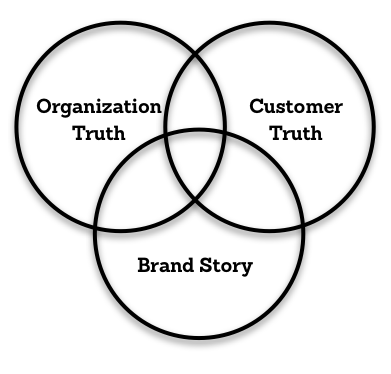Seeking truths and telling lies
Seth Godin, the world’s most famous marketer, famously published a book called All Marketers are Liars. In it, he describes the way successful marketers invent stories (i.e. tell lies) to sell products and services. There’s power in that idea, but it’s nothing new. If you’ve progressed to a marketing leadership role at a health system, you intuitively know the power of stories.
What you might not know is that effective storytelling requires two specific kinds of support to ensure that it builds brand rather than devaluing it. These supports are two different flavors of objective truth, each serving as a kind of pillar that a good brand story bridges. I call this the two truths and a lie framework. As a marketing leader, you can use this framework to evaluate whether the ideas your agency is presenting are likely to go the distance or fall flat.
It looks something like this:

Seeking truths
Organization truths
To make a brand story work, there are two kinds of truths you need. The first is an organization truth. This is an objective fact about your organization. For instance, one objective fact about Wendy’s is that their hamburgers are square. That’s not necessarily a benefit to the consumer, who doesn’t care what shape hamburger he eats, but it’s a truth about Wendy’s product, and one that distinguishes them from other burger joints.
Looking at the world of healthcare providers, take the example of a health system that is affiliated with an academic institution. There’s no inherent customer benefit to academic affiliation. The affiliation, however, is a fact. That’s an organization truth, and the first support for a brand story.
Customer truths
The second truth is a customer truth. And while an organization truth is usually a cold, hard fact, a good customer truth is fuzzier. It’s most likely not a demographic fact, but instead an insight about your customer’s worldview. Good ones usually don’t sound like “my customer is between the ages of 45 and 65.” Instead, they sound like “My customer wants a good deal for their money.” In healthcare it may sound something like “My customer believes they shouldn’t have to compromise on their healthcare.”
Good customer truths need not be logical or rational. It’s much more important that they have emotional resonance. It’s better, by far, to connect to something your customer believes for irrational reasons than to something your customer can clearly explain. Good customer truths also need not be directly tied to healthcare. It’s better to find something your customer believes deeply about the world at large than something they believe shallowly about healthcare.
Telling lies
With a firm grasp on the twin pillars of customer and organization truths, a good advertiser can write the brand story (i.e. the lie). The brand story builds a bridge between the two truths. It’s a story your customer wants to believe, and it fits with their worldview. And it has an important role for your organization truth. You’ve heard thousands of examples of stories like this, and it’s likely you don’t remember the organization truth or the particular worldview of yours that the advertiser tapped into. What you remember is the story.
For instance, you remember that the answer to the question “Where’s the Beef?” is “at Wendy’s.” You don’t notice how adeptly that commercial tapped into the truth that most customers want a good deal for their money. And you might not notice that the organization truth is that Wendy’s hamburgers, by virtue of being square, actually have just a little more beef in them.
For a health system example, you might remember that The Cleveland Clinic offers second opinions for cardiology patients. But you don’t see the customer truth that powers this message from behind the scenes (that people with serious heart conditions often worry that they might not be getting the right treatment.) And it’s likely that you don’t know the organizational truth, which is that Cleveland Clinic’s heart and heart surgery program has been ranked No. 1 in the nation since 1995.
Gut-checking your agency
Most marketing agencies, no matter their specialization (or lack thereof) can tell a story. And that can make it hard for you, the marketing director, to predict whether a particular campaign is going to help build your brand and reach your goals or leave you and your customers wanting more. Better to find out at the beginning than after you’ve invested the media budget.
If you find yourself in a position like this, consider applying the Two Truths and a Lie framework. Ask your agency to share the customer truth and the organization truth they used to build the brand story, and gut-check them against your experience. You just might find better results on the other side.

